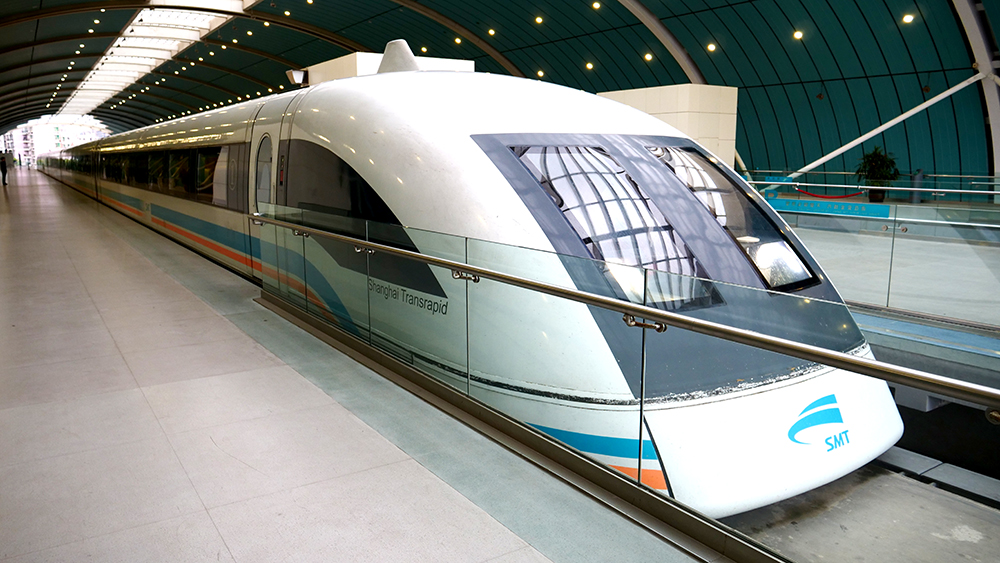Gone are the days when trains were believed to be the means of slow transportation. With other modes of transportation like airways dominating the game, people have diverted their attention from railways. However, with the radicalization of technology, many of the fastest trains in the world are creating new definitions of transportation.
In recent years, Japan constructed N700S (‘S’ stands for Supreme) trains. The Japanese authorities will inaugurate this train in July 2020. The operation division of JR Tokai’s (Central Railway of Japan’s) Shinkansen tested this bullet train. As a result, it was found that the train possesses the power to obtain an unimaginable maximum speed of 362 kph.
On a similar note, following are the top 10 fastest trains of the world which stun their commuters with their unbelievable speeds.
1. Shanghai Maglev – The Fastest Trains (Globally)
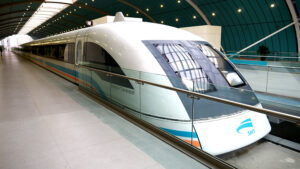
The Shanghai Maglev (aka Shanghai Transrapid) completely justifies its dominance in the industry with its speed of 431 kph. This fastest bullet train began its commercial operation in April 2004 from Longyang Road Station to Shanghai Pudong International Airport. It is the oldest functioning commercial magnetic levitation train today while also being the fastest commercial electric train internationally.
The rake model of the Shanghai Maglev train was built by the consortium of ThyssenKrupp, Siemens, and a couple of Chinese local companies. The length of 502 feet of this train is divided into three classes depending on the comfort level. However, these classes can collectively carry 574 passengers in total.
2. Fuxing Hao CR400AF/BF – Second Fastest Trains
These Fuxing trains run with a maximum speed of 401 kph from Beijing South Station to Shanghai Hongqiao Station. The CR in the model names of the Fuxing trains stands for China Railways. Local people also call these trains with their epithets ‘Red or Blue Dolphin’ and ‘Golden Phoenix’. Four foreign and two local Chinese companies came together to for this bullet train China boasts.
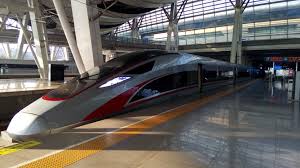
They began their commercial operation on 26th June 2017, with the capacity of 556 passengers each. The Fuxing trains have WiFi access and comfortable seating for First, Second, and Third-class passengers.
3. Shinkansen E5 Series – Third Fastest Trains
The electric active suspension is the major characteristic of the Japanese Shinkansen E5 Series bullet trains. With an unimaginable maximum speed of 361 kph, they secure the third spot in this list. Kawasaki and Hitachi built the parts of the E5 Series trains. These parts were cumulated to form the operational unit, later on. The designing aspects of the exterior are alluring with the Hayabusa logo over the shimmering green paint.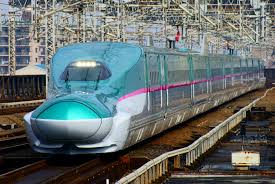
The Shinkansen E5 Series trains started operating from 2011 on different routes including the one from Tokyo to Shin-Aomori. The first car is on the Tokyo end and it continues till the 10th car on the Aomori end. It features 3 classes – Gran, Green, and Ordinary class.
4. AGV Italo
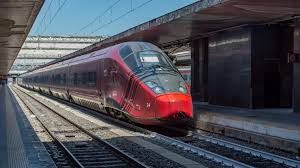
This Italian beauty is Europe’s fastest train operating at 359.8 kph from Rome to Naples. It started functioning in the year 2007. Since then, this electric train carries a maximum of 446 passengers every day. ‘Pegase’ inspired the exterior design of AVG Italo. Talking about the interior, AVG Italo features a higher ratio of sitting area per length of the carriage, without compromising the comfort and luxury of the passengers.
5. Siemens Velaro E
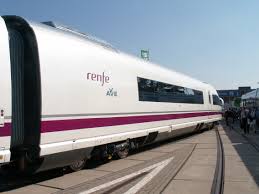
The Spanish Railway company, Renfe, started a high-speed railway service under the name of Alta Velocidad Española. Siemens that built the second generation of its original Velaro trains. Later, these trains were named as Siemens Velaro E in Spain. Locally known as Renfe AVS, this train obtains a maximum speed of 349.2 kph while travelling from Barcelona to Madrid. The 8 passenger cars of this train can carry 404 passengers at a time.
6. Talgo 350
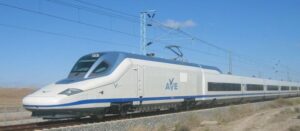
Another Spanish train, Talgo 350 runs at a maximum speed of 349 kph. It serves two lines named S-102 and S-112. Both these lines start from Madrid and Seville, to continue down to different parts of the country. The design of the driving end of the train resembles a duck. This is the reason behind its nickname ‘Pato,’ which is Spanish for the duck. These trains are built using Canadian power car technology. Renfe runs the Talgo 350 services across Japan for daily commuters.
7. Haramain Western Railway
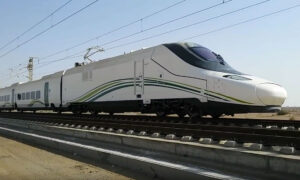
‘Haramain’ refers to the holy cities of Mecca and Medina in Saudi Arabia. The Haramain Western Railway, also known as Mecca Medina high-speed railway, connects three cities viz. Mecca, King Abdulla Economic City, and Medina. This electric train takes 2 hours to cover the distance of 449 km from Mecca to Medina with the highest speed of 345 kph. The maximum of 417 passengers commutes every day on this train since its opening in October 2018. Serving its main purpose fruitfully, the Mecca Medina High-Speed Railway has reduced the traffic of pilgrim vehicles on the roads of the country.
8. Deutsche Bahn ICE

ICE stands for Intercity Express which is a system of fast trains primarily running in the major European countries like Germany, Switzerland, France, Netherlands, Denmark, Austria, and Belgium. This magnum opus of the European railway system is the bellwether of Deutsche Bahn (German State Railway). It runs between different European cities with a maximum speed of 320 kph. Preferred by business travellers or long-distance passengers, it has often impelled people to choose trains over flights.
9. Korail KTX
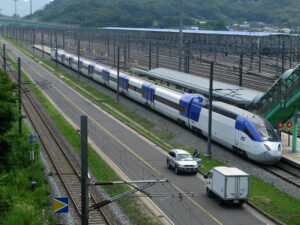
Operated by Korail, this train is the high-speed rail system of South Korea that connects multiple cities like Seoul, Busan, Suseo, and Pyeongtaek. It functions at a regular maximum speed of 305 kph, allowing 935 passengers in its design of 20 cars.
10. Alstom Euroduplex
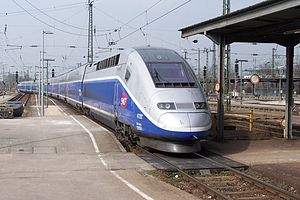
The Alstom Euroduplex is a double-decker electric train, running at the maximum speed of 320 kph. The French multinational company, Alstom, built this multiple unit train which now operates between different European and African cities. Commonly known as Euroduplex, this train comes with a 10-car design with the view of traveler’s convenience in mind.
India plans on entering the game with its Bullet train from Mumbai to Ahmedabad. The council of Union Ministers have approved the use of Japanese technology that would set the standard of the bullet train speed in India at 320 kph.
